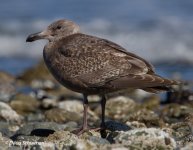Good point, fair question.
It is subtle, but in the examples in Howell & Dunn, note how the wingtips, secondaries and tail appear visibly darker than the upperparts. The dark wingtips and tail are also specifically mentioned in the caption to photo H1.5.
I am not convinced this is the case in the bird posted here. Its plumage appears dark allover (though this may be partly due to harsh sunlight perhaps, creating shadow effects on the underparts?).
Perhaps it is too dark for GWGull - but who knows? Noone is banding GWGulls up there in Alaska, so we do not have a full understanding of their variability.
In any case, dark 1st-cycle birds are sometimes seen in Japan (e.g.
http://www23.tok2.com/home/jgull/020205/GW.html), far from Western Gull influence.
It is true, of course, that many backcrosses occur, and that these can have very little mixed genes left. The question that interests me most is: are there any features betraying their mixed ancestry visible still in such birds in the field - let alone in a single photograph ? If no evidence is visbile, I normally refrain from bringing up the issue of hybrids/backcrosses.





